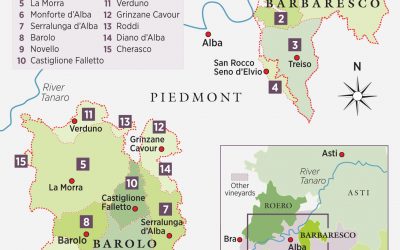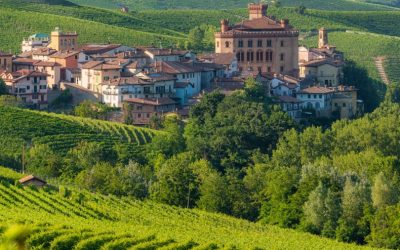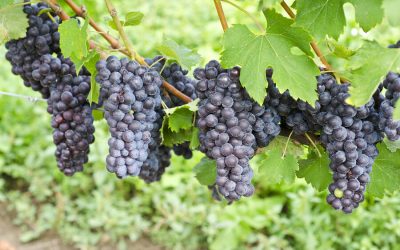Is Barolo sweet or dry?
As one of Italy’s most esteemed wines, Barolo, often referred to as “the king of wines,” frequently captures the interest of both novice wine enthusiasts and seasoned connoisseurs. Its complex flavor profile and aging potential are widely recognized. However, for those less familiar with this rich, full-bodied red, one question that often arises is whether Barolo is sweet or dry.
Is Barolo sweet or dry?
Barolo is a dry wine. Its high tannin and alcohol content contribute to its dry and long finish. While it can develop intense flavors such as roses, red cherries, and raspberries, these are taste profiles, not indications of sweetness. Barolo is considered one of the driest wines available, often referred to as “bone dry.” Discover more about What is Barolo?
Barolo, including those from the Serralunga d’Alba zone, is a dry wine. Known for its high tannin levels, full body, and distinct aromas of roses, tar, and, often with age, truffles and leather, Barolo is a complex wine with a decidedly dry finish.
Serralunga d’Alba is one of the key villages in the Barolo region, and its vineyards are highly prized for producing wines with a particular depth and robustness. Wines from Serralunga d’Alba are renowned for their firm structure and longevity, as well as their rich, concentrated flavors.
Food Pairings
When it comes to food pairing, Barolo is versatile due to its high acidity and tannic structure. Here are a few suggestions:
- Meat: Due to its robustness, Barolo pairs excellently with rich, hearty meats. Think of dishes like braised beef, lamb, or game meats. A traditional pairing is with ‘Brasato al Barolo’, a pot roast braised in Barolo wine.
- Cheese: Aged cheeses such as Parmigiano-Reggiano or Pecorino can stand up to Barolo’s high tannin levels. The fat content in the cheese can also help soften the perception of the tannins.
- Truffle dishes: Given Barolo’s noted compatibility with truffle flavors, dishes featuring this gourmet delicacy can be a great match.
- Pasta: Rich, meat-based pasta dishes, like ragù, complement the strong structure of Barolo.
Drinking Tips
Barolo benefits significantly from decanting, as it allows the wine to breathe and softens its high tannins. It’s also typically best served slightly below room temperature, around 60-65°F (16-18°C). And remember, due to its complexity and aging potential, Barolo is a wine that can be savored slowly, either with food or on its own.
So, whether you’re planning a sumptuous dinner or simply want to enjoy a special wine, a Barolo DOCG from Serralunga d’Alba, such as the Italian Delight you mentioned, is a great choice. Just remember to give this powerful wine the time and respect it deserves to fully enjoy its depth of flavor.
What does Barolo taste like?
Barolo is renowned for its robust flavor profile. It typically has high acidity and high tannin levels, which contribute to its powerful structure and bone-dry finish. A young Barolo may have flavors of cherries, tar, roses, and herbs. As it ages, it can develop more nuanced notes of dried fruit, truffles, tobacco, anise, and sweet spice. Despite these complex flavors, it’s important to note that Barolo is not a sweet wine. While it may exhibit fruity or sweet spice notes, these are flavors and aromas, not sweetness from residual sugar. What is the main grape in Barolo?
Tasting Nebbiolo: Barbaresco and Barolo with Jeff Porter at Del Posto | Follow That Somm

Barolo is a red wine made from the Nebbiolo grape in the Piedmont region of northwestern Italy. It is famous for its rich, full-bodied character and its complex flavors and aromas.
What type of wine is Barolo?
Barolo is a dry, red wine known for its depth and complexity. It is considered one of Italy’s finest wines and is sometimes referred to as “the king of wines and the wine of kings.” Barolo is made in accordance with strict regulations, including a minimum aging requirement (38 months, with at least 18 in oak) and 100% Nebbiolo grapes. These regulations help ensure the high quality of Barolo wines and their potential for long-term aging.
What are the characteristics of Barolo?
Barolo is characterized by its full body, high tannin levels, and high acidity. It has a garnet color that tends to become brick orange as it ages. The wine is known for its pronounced aromas of tar and roses, along with other flavors such as berries, cherries, licorice, and herbs. Its complex bouquet and powerful structure make it a wine that can age for decades.
What is the difference between Nebbiolo and Barolo?
Nebbiolo is a grape variety, while Barolo is a wine named after the region in which it is produced. All Barolo wines are made from the Nebbiolo grape, but not all Nebbiolo wines are Barolo. The Nebbiolo grape is grown in several other areas and used to produce different styles of wine, such as Nebbiolo d’Alba, Roero, and Gattinara. The difference between Barolo and these other Nebbiolo-based wines lies in the specific regulations and production methods for each region, as well as variations in terroir. These differences can greatly influence the flavor, structure, and aging potential of the resulting wines.
Conclusion
Barolo, originating from the Nebbiolo grape in the Piedmont region of Italy, is considered a dry, not sweet, wine. Despite the rich array of flavors it can exhibit, from cherries, tar, roses, to more complex notes of truffles, tobacco, and anise with aging, these characteristics do not denote sweetness from residual sugar. Instead, they add to the wine’s complexity and depth, enhancing its appeal to those seeking a robust, structured, and intricately flavored wine.




